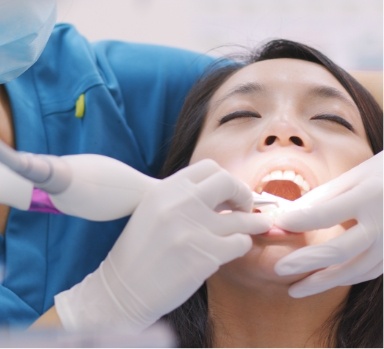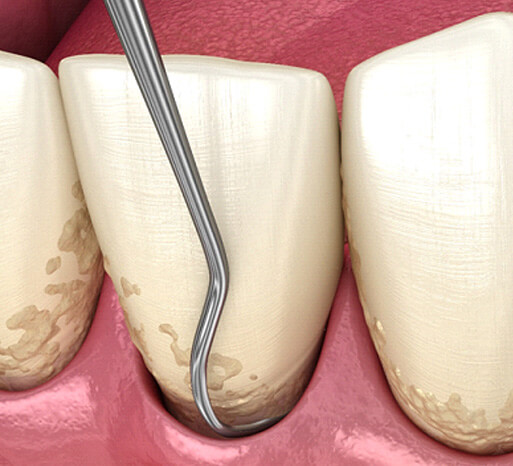Gum Disease Treatment – Itasca, IL
Better Gum Health For a Lifetime
Gum disease affects millions of Americans with more than half never recognizing the symptoms until it has significantly progressed. Without proper treatment, bacterial accumulation in the soft oral tissues can lead to bone and tooth loss as well as worsening health conditions. Fortunately, with gum disease treatment in Itasca, IL at Hamilton Lakes Dentistry, our dentists and dental team can help you take back your gum health and enjoy a brighter future. Call us today if you notice your gums appear inflamed or bleed when brushing and flossing.
Why Choose Hamilton Lakes Dentistry for Gum Disease Treatment?
- Laser Periodontal Therapy for Greater Accuracy
- Gentle Dental Team Who Ensures Optimal Comfort
- Flexible Financing Available
What Are Bone Disease and Gum Disease?

When afflicted with gum disease, you’ll notice that your gums appear red and tender, and may even bleed after regular brushing and flossing. If only in the initial stage, gingivitis, the symptoms can be reversed with the help of regular professional cleanings and good at-home oral hygiene habits. However, if you do not keep up with your dental routine, gingivitis will likely progress to periodontitis. Also known as bone disease, this damaging condition is the result when bacteria and plaque are allowed to spread beneath the gumline, resulting in gum pocket formation. As the bacteria break down your jawbone, teeth will become loose and eventually fall out.
Gum Disease Treatments

If you’re faced with gum disease and need safe and effective treatment, you’ll be pleased to learn that Drs. French and Dr. Conti are experienced in treating damaged soft oral tissues. With various periodontal solutions available, we can determine the right course of action during an initial consultation so that you can work to take back your gum health. Some of our available treatments include:
Read More Read Less
Professional Dental Cleaning

During a professional dental cleaning, we will remove any bacterial accumulation that exists above and below the gumline. This will help to clear away plaque that cannot be removed with regular brushing and flossing. If our team discovers that you are in the early stage of gum disease or have a more advanced case, you’ll likely be required to attend two more of these same cleanings each year to avoid further damage.
Scaling and Root Planing

Scaling and root planing is a two-part process that is necessary for patients to avoid more damaging stages of gum disease. We will administer local anesthesia before starting treatment so that you will remain comfortable. We will then begin with the scaling portion of the treatment, which includes removing plaque and tartar buildup from above and below the gumline. One of our skilled hygienists will then move on to the root planing portion of treatment, which involves smoothing the tooth root to encourage reattachment and minimize the potential for bacteria to reinfect the area in the future.
Once scaling and root planing is complete, our team may include antibiotic therapy, which will be applied to the gum pockets, to encourage proper healing and complete elimination of bad oral bacteria.
Scaling & Root Planing

Gum disease often calls for a different type of dental cleaning (sometimes referred to as a deep cleaning) that can be divided into two steps: scaling and root planing. Not only is the harmful plaque contributing to your gum disease removed, but steps are taken to reduce the chances of future bacterial buildup. Read on for a closer look at what you can expect from scaling and root planing.
Read More Read Less
Do I Need Scaling & Root Planing?

Sometimes all you need to do to improve the health of your gums is to simply commit to brushing and flossing more often. Once your gum disease reaches a certain stage, though, scaling and root planing may be necessary.
If your gums are red, swollen, and have a tendency to bleed easily, scaling and root planing may be warranted. Other telltale signs that the treatment is needed include bad breath that doesn’t go away, visible plaque accumulating near the gums, and gum recession.
The Process of Scaling & Root Planing

For the scaling step, our team will focus on getting rid of harmful plaque and tartar from the mouth. Not only will we clean the area above the gumline, but we will also pay close attention to any gum pockets that have formed. Any bacterial deposits that have appeared in these pockets will be removed.
The second step, root planing, involves gently smoothing out the roots of the teeth. The purpose of this step is twofold; it makes it more difficult for bacteria to accumulate on the roots (thus reducing the risk of further problems), and it aids with the reattachment of the gum tissue.
Scaling and root planing often require multiple appointments. The exact number needed depends on how severe your gum disease currently is.
Aftercare Tips for Scaling & Root Planing

If a local anesthetic was used during your scaling and root planing procedure, you should wait until the numbness has completely worn off before you eat anything. There may be some slight discomfort in your gums for at least a few days, but taking an over-the-counter painkiller can often help.
You need to take steps to keep the risk of infection to a minimum while your mouth is healing. For example, you can periodically rinse with salt water. If you were prescribed any antibiotics, carefully follow any instructions for taking them.
Your teeth may be temporarily more sensitive than normal after scaling and root planing. Stay away from any foods that can make sensitivity worse; this effectively means not eating or drinking anything that’s hot, cold, spicy, or acidic. Plan on sticking to a soft food diet for at least two days following your scaling and root planing procedure.
It should take about one to two weeks for your gum tissue to fully heal after scaling and root planing. Any discomfort you’re experiencing should eventually go away on its own.
Gum Disease Treatment Frequently Asked Questions
Are you unfamiliar with the term “gum disease?” Do you feel unaware of what to look for to know if you have a problem with your gums? At Hamilton Lakes Dentistry, Drs. French, Dr. Conti, and our team are here to offer clarity and confidence by answering some of our patient’s most frequently asked questions. Feel free to review the information below and contact us if you’d like to further discuss.
When is gum surgery needed?
Gum surgery is typically not recommended unless our team cannot properly treat the soft oral tissues with nonsurgical solutions (i.e., scaling and root planing, antibiotic therapy, and professional dental cleaning). Should this be required, you can trust that we will ensure you remain in good hands.
How can you prevent gum disease?
Preventing gum disease requires committing to your oral hygiene routine. You must brush your teeth twice each day for two minutes, floss at least once before going to bed, and rinse with an antiseptic mouthwash. You should also be mindful of any bad habits you might practice such as smoking or chewing on inanimate objects that can damage teeth and cause gum recession.
What is a gum graft?
If you require a gum graft, you’ll undergo a procedure that involves removing existing tissue from the roof of your mouth and having it applied to the affected area of your gums (i.e., exposed tooth root). This will heal over time and allow for a reduced risk of gum disease and tooth sensitivity.
What is a gum or periodontal abscess?
If you have a gum or periodontal abscess, you can expect to see a small pocket of pus forming inside the gum tissue. You may see it protrude when opening your mouth or smiling. This typically occurs when bacteria enter the gums and cause the tissue to disintegrate or when harmful plaque reaches tooth roots and nearby bone.
